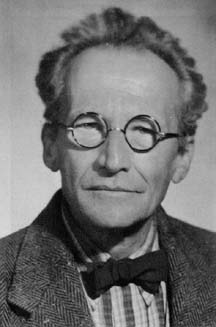Adapted from
Eric's Treasure Trove. Go to original for links shown in blue, and references.
 Austrian physicist who invented
Wave Mechanics in 1926.
Wave mechanics was an independent formulation of
Quantum Mechanics, equivalent
(but not obviously so) to Heisenberg's
Matrix Mechanics. Like
Matrix Mechanics,
Wave Mechanics mathematically described the behavior of
electrons
and atoms.
The central equation of wave mechanics, now known as the
Schrödinger Equation ,
turned out to be much simpler for physicists to solve in most cases.
Austrian physicist who invented
Wave Mechanics in 1926.
Wave mechanics was an independent formulation of
Quantum Mechanics, equivalent
(but not obviously so) to Heisenberg's
Matrix Mechanics. Like
Matrix Mechanics,
Wave Mechanics mathematically described the behavior of
electrons
and atoms.
The central equation of wave mechanics, now known as the
Schrödinger Equation ,
turned out to be much simpler for physicists to solve in most cases.
Schrödinger shared with Dirac the 1933
Nobel prize in physics.
Additional biographies:
MacTutor
(St. Andrews), and the Nobel site.
References
Mehra, J. and Rechenberg, H., The Historical Development of Quantum Theory, Vol. 5: Erwin Schrödinger and the Rise of Wave Mechanics, Part 1: Schrödinger in Vienna and Zurich 1887-1925.
New York: Springer-Verlag, 1982.
Moore, W. J., Schrödinger: Life and Thought. Cambridge: Cambridge University Press, 1989.
Schrödinger, E. C., Science Theory and Man. New York: Dover, New York: 1957.
Schrödinger, E., Space-Time Structure. Cambridge, England: Cambridge University Press, 1985.
Schrödinger, E., Statistical Thermodynamics, 2nd ed. Cambridge, England: Cambridge University Press, 1952.
Schrödinger, E., What is Life? The Physical Aspect of the Living Cell.
Cambridge, England: Cambridge University Press, 1945.
© 1996-9 Eric W. Weisstein
1999-01-22
 Austrian physicist who invented
Wave Mechanics in 1926.
Wave mechanics was an independent formulation of
Quantum Mechanics, equivalent
(but not obviously so) to Heisenberg's
Matrix Mechanics. Like
Matrix Mechanics,
Wave Mechanics mathematically described the behavior of
electrons
and atoms.
The central equation of wave mechanics, now known as the
Schrödinger Equation ,
turned out to be much simpler for physicists to solve in most cases.
Austrian physicist who invented
Wave Mechanics in 1926.
Wave mechanics was an independent formulation of
Quantum Mechanics, equivalent
(but not obviously so) to Heisenberg's
Matrix Mechanics. Like
Matrix Mechanics,
Wave Mechanics mathematically described the behavior of
electrons
and atoms.
The central equation of wave mechanics, now known as the
Schrödinger Equation ,
turned out to be much simpler for physicists to solve in most cases.